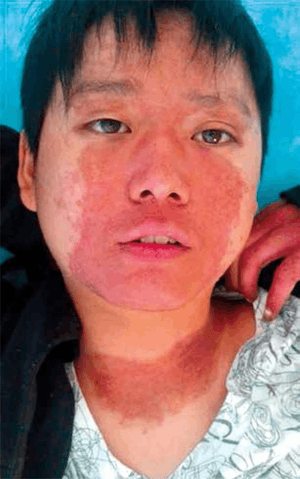Pellagra
Background
- Pellagra is the deficiency of Niacin (Vitamin B3).
- Niacin is an important factor for the production of NADH and NADPH, which are important for redox reactions.
- Deficiency therefore affects tissues with high turnover, including skin, GI tract and brain
- Niacin is either consumed in the diet or converted from tryptophan by the hepatic kynurenine pathway in the liver.
- Neurological symptoms can also be exacerbated by supplementation by other B vitiamins, particularly B1, B2, B6, and B12. Mechanism is unknown but may be secondary to the increased demand of NAD.
Drugs that inhibit niacin production
- Azathioprine
- Chloramphenicol
- Ethionamide
- 5-Fluorouracil
- Isoniazid
- 6mercaptopurine
- Pyrazinamide
Conditions that decrease niacin GI absoprtion
- Colitis
- Celiac disease
- Crohn's disease
- Ulcerative colitis
- Cirrhosis
- Gastrectomy patients
Clinical Features

Casal's Necklace in a case of isoniazid-induced pellagra.
Niacin deficiency classically causes the 4 D's: Dermatitis, Diarrhea, Dementia and Death.
- Skin photosensitivity and rash. Erythematous and scaly. May be mistaken for sunburn.
- secondary to UV damage and decreased repair and hence the desquamation, keratosis and erythema is most common in sun-exposed skin
- "Casal's Necklace." Reddish rash surrounding the neck, and on the hands and feet. This is a photosensitivity rash in the exposed areas of the neck. Originally described by Gaspar Casal in 1735.
- GI symptoms
- secondary to decreased cell turnover
- Neurological symptoms
- "Pellagra encephalopathy," depression, anxiety, altered mental status, hallucinations, delusions, affective disorders, cognitive dysfunction.
- Niacin deficiency is often associated with chronic alcohol use secondary to nutritional deficiency and malabsorption.
Differential Diagnosis
Rash
- Acute generalized exanthematous pustulosis
- Allergic reaction
- Aphthous stomatitis
- Atopic dermatitis
- Chickenpox
- Chikungunya
- Coxsackie
- Dermatitis herpetiformis
- Erysipelas
- Exfoliative erythroderma
- Impetigo
- Measles
- Miliaria (Heat Rash)
- Necrotizing fasciitis
- Pellagra
- Poison Oak, Ivy, Sumac
- Psoriasis
- Pityriasis rosea
- Scabies
- Seborrheic dermatitis
- Serum Sickness
- Smallpox
- Shingles
- Tinea capitus
- Tinea corporis
- Vitiligo
Vitamin deficiencies
- Vitamin A deficiency
- Vitamin B deficiencies
- Vitamin B1 deficiency (Thiamine)
- Vitamin B3 deficiency (Pellagra)
- Vitamin B9 deficiency (Folate)
- Vitamin B7 deficiency (Biotin)
- Vitamin B12 deficiency
- Vitamin C deficiency (Scurvy)
- Vitamin D deficiency (Rickets)
- Vitamin E deficiency
- Vitamin K deficiency
Evaluation
Management
- Niacin supplementation.
Disposition
See Also
External Links
References
- Badaway, Abdulla. “Pellagra and Alcoholism: a biochemical perspective.” Alcohol and alcoholism 2014; vol 49, No 3, pages 238-250
- Lopez, Marta, et al. “Pellagra Encephalopathy in the context of alcoholism: review and case report.” Alcohol and alcoholism. Vol 49. No 1. pages 38-41. 2014.
This article is issued from
Wikem.
The text is licensed under Creative
Commons - Attribution - Sharealike.
Additional terms may apply for the media files.